Mariana of Austria
Mariana of Austria or Maria Anna (24 December 1634 – 16 May 1696) was Queen of Spain from 1649 until her husband and uncle, Philip IV, died in 1665. She was then appointed regent for their three-year-old son Charles II, and due to his ill health remained an influential figure until her own death in 1696.
| Mariana of Austria | |||||
|---|---|---|---|---|---|
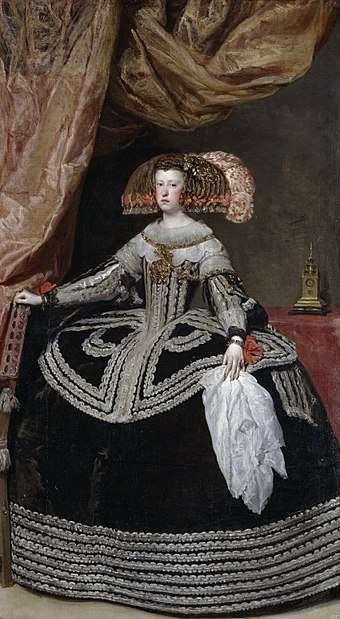 Mariana of Austria by Velázquez | |||||
| Queen consort of Spain | |||||
| Tenure | 7 October 1649 – 17 September 1665 | ||||
| Born | 24 December 1634 Wiener Neustadt, Archduchy of Austria, Holy Roman Empire | ||||
| Died | 16 May 1696 (aged 61) Uceda Palace, Madrid, Spain | ||||
| Burial | |||||
| Spouse | Philip IV, King of Spain
( m. 1649; died 1665) | ||||
| Issue Detail | Margaret Theresa, Holy Roman Empress Philip Prospero, Prince of Asturias Charles II, King of Spain | ||||
| |||||
| House | Habsburg | ||||
| Father | Ferdinand III, Holy Roman Emperor | ||||
| Mother | Maria Anna of Spain | ||||
| Religion | Roman Catholic | ||||
Her regency was overshadowed by the need to manage Spain's post-1648 decline as the dominant global power, internal political divisions and the European economic crisis of the second half of the 17th century. The inability of her son Charles to produce an heir led to constant manoeuvring by other European powers, which ultimately ended in the 1701 to 1714 War of the Spanish Succession.
Early life
Maria Anna was born on 24 December 1634 in Wiener Neustadt, second child of Maria Anna of Spain and her husband Ferdinand (1608-1657), who became Holy Roman Emperor in 1637. Her parents had six children, of whom only Maria Anna and two brothers survived to adulthood; Ferdinand (1633-1654), and Leopold (1640-1705), elected emperor in 1658.[1]
Queen of Spain

The Habsburgs often married within the family to retain their lands and properties, and in 1646 Maria Anna was betrothed to her cousin and heir to the Spanish throne, Balthasar Charles, Prince of Asturias. His death three months later left her without a prospective husband and her widowed uncle Philip IV without an heir.
On 7 October 1649, Philip married his fourteen-year-old niece in Navalcarnero, outside Madrid; from then on, she was known by her Spanish name 'Mariana.' Her exclusion from political life meant she focused on religion and education, which society viewed as fitting women's 'role' as nurturers and providers of moral guidance.[2]
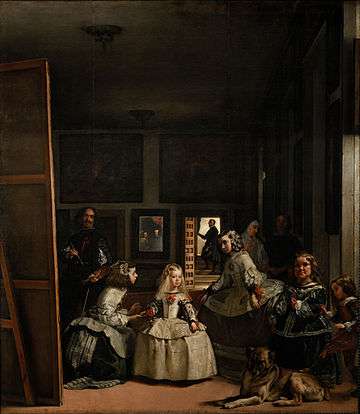
Only two of their five children survived to adulthood; in 1666, Margaret Theresa (1651-1673) married her maternal uncle Leopold I, Holy Roman Emperor. Mariana's second daughter, Maria Ambrosia, lived only fifteen days, followed by two sons, Philip Prospero (1657-1661) and Ferdinand Thomas (1658-1659).
On 6 November 1661, Mariana gave birth to her last child, Charles, later known as El Hechizado or "The Bewitched", in the belief his disabilities were caused by "sorcery." In his case, the so-called Habsburg jaw was so pronounced he spoke and ate with difficulty all his life. He did not learn to walk until he was eight and never attended school, but foreign observers noted his mental capacities remained intact; others speculated the Regents overstated his defects to retain political control.[3]
It has been suggested Charles suffered from the endocrine disease acromegaly and a combination of rare genetic disorders often transmitted through recessive genes, including combined pituitary hormone deficiency and distal renal tubular acidosis.[4] However, his elder sister did not appear to suffer the same issues and the authors of the most significant study state it has not been demonstrated (his) disabilities...were caused by...recessive alleles inherited from common ancestors.[5]
Regardless of the cause, Charles suffered ill health throughout his life, and the Spanish court was split by the struggle between his co-heirs, Louis XIV and Emperor Leopold. His death was expected almost from birth; he was "short, lame, epileptic, senile and completely bald before 35,...repeatedly baffling Christendom by continuing to live."[6]
Regency
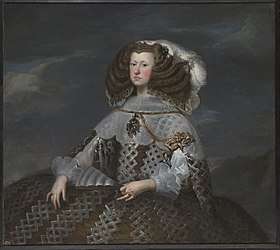
When Philip died on 17 September 1665, Charles was only three; Mariana was appointed regent, advised by a Regency Council, until he became a legal adult at the age of 14. She adopted the system of using a valido or 'favourite' established by Philip in 1620 and widely used elsewhere in Europe. The first was Juan Everardo Nithard, an Austrian Jesuit and her personal confessor who came with her from Vienna; as Philip's will excluded foreigners from the Regency Council, he had to be naturalised, causing immediate resentment.[7]
A 'foreigner' herself, the two men habitually identified as her 'favourites' were also outsiders; Nithard and Valenzuela, who came from the lower rank of Spanish nobility.[8] Even modern English-language sources are often based on contemporary sources that viewed women as incapable of ruling on their own and thus imply a sexual relationship.[9]
In reality, Mariana used a variety of advisors, including Castilian nobles such as Count Peñaranda and the Marquis de Aytona. Historian Silvia Mitchell disputes whether either Nithard or Valenzuela can truly be considered a 'valido', since Mariana retained power, rather than delegating it to them.[10]
Her son's poor health and lack of an heir led to a constant struggle between Mariana's 'Austrian' faction, and a 'French' faction, nominally led by his illegitimate half-brother, John of Austria the Younger. Spain was also divided into the Crowns of Castile and Aragon, whose very different political cultures made it almost impossible to enact reforms or increase taxes. Government finances were in perpetual crisis, the Crown declaring bankruptcy in 1647, 1652, 1661 and 1666.[11]
The external situation facing Mariana would have challenged even the most competent ruler; Spain was financially exhausted by almost a century of continuous war. Her reign also coincided with the Little Ice Age, a period of cold and wet weather that affected the whole of Europe in the second half of the 17th century. Between 1692 to 1699, an estimated 5-10% of the European population starved to death.[12]
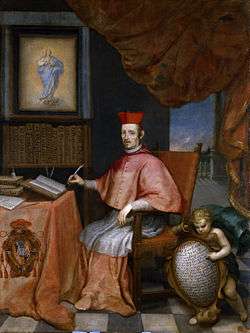
The new government inherited a wide range of economic and political problems. The long-running Portuguese Restoration War was the most urgent, followed in May 1667 by the War of Devolution, when France invaded the Spanish Netherlands and the Spanish province of Franche-Comté.[13] The need to reduce spending resulted in the 1668 treaties of Aix-la-Chapelle and Lisbon ended the wars with France and Portugal.[14]
Peace ended the constant drain of Spanish resources, while Aix-La-Chapelle forced France to return most of the territories over-run in 1667 to 1668. Despite this, the army consisted them a humiliation; in June 1668, Joseph Malladas, an Aragonese captain living in Madrid, was executed for plotting to murder Nithard, reputedly on John's behalf.[15] An internal power struggle ended with Nithard becoming Ambassador to Rome in February 1669; he was succeeded by Aytona, who died in 1670 and was replaced by Valenzuela, a member of her household since 1661.[16]
In 1672, Spain was dragged into the Franco-Dutch War; Valenzuela was dismissed when Charles came of age in 1675, but Spanish policy continued to be undermined by the struggle for power. Marianna reinstated the regency in 1677 on the grounds of Charles's ill-health and Valenzuela was restored, before John finally gained control in 1678. He died in September 1679 and Marianna became regent once again; one of his final acts was arranging the marriage of Charles to 17-year-old Marie Louise of Orléans, which took place in November 1679.[17]
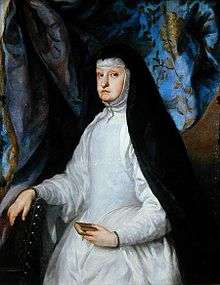
Marie Louise died in February 1689, without producing an heir; as with many deaths of the period, limited medical knowledge led to allegations she was poisoned. Modern assessments of her symptoms conclude it was almost certainly appendicitis, possibly from the treatments undertaken to improve fertility. Her replacement was Maria Anna of Neuburg, one of 12 children whose family reputation for fertility made them popular choices for royal marriages. Of her sisters, Maria Sophia married Peter II of Portugal, while Eleonore was the third wife of Emperor Leopold. Maria Anna was aunt to future emperors Joseph I and Charles VI, making her an ideal choice for the Austrian faction.[18]
Charles remained childless; by that time, he was almost certainly impotent, his autopsy later revealing he had only one atrophied testicle.[19] As his health declined, internal struggles over the succession became increasingly bitter, leadership of the pro-French faction passing to Fernández de Portocarrero, Cardinal and Archbishop of Toledo.
Under the influence of the 'Austrians,' in 1690 Spain joined the Grand Alliance in the Nine Years' War with France. It declared bankruptcy again in 1692 and by 1696, France occupied most of Catalonia; Mariana retained power with the support of German auxiliaries under Maria Anna's brother Charles Philip, many of whom were expelled after Mariana's death.[20] She died on 16 May 1696 at the Uceda Palace in Madrid, at the age of sixty-one; the cause is thought to have been breast cancer.[21]
Issue
- Margaret Theresa (12 July 1651 – 12 March 1673), first wife of Leopold I, Holy Roman Emperor
- Maria Ambrosia de la Concepción (7 December 1655 – 21 December 1655)
- Philip Prospero, Prince of Asturias (28 November 1657 – 1 November 1661)
- Ferdinand Thomas Charles (23 December 1658 – 22 October 1659)
- Charles II of Spain (6 November 1661 – 1 November 1700)
Legacy
Mariana supported the 1668 mission led by Diego Luis de San Vitores and Saint Pedro Calungsod to convert the indigenous Chamorro people of Guam and the Mariana Islands to Christianity.
The Portrait of Mariana painted by Diego Velázquez was commissioned by Philip and is the only known full-length painting of her. The original is in the Prado Museum in Madrid; a copy was sent to her father Ferdinand and is held by the Kunsthistorisches Museum in Vienna.
Several other portraits of her were made, including Juan Bautista Martínez del Mazo's Queen Mariana of Spain in Mourning, 1666. She also appears as a detail in Velasquez' masterpiece Las Meninas which features her daughter Margaret Theresa.
Mariana of Austria is depicted as regent in a brief scene during the fourth episode of Juana Inés, a television mini-series centered around Sor Juana Ines de la Cruz, Mariana's increasingly famous and controversial subject in the colony of New Spain, produced by Canal Once.
Family tree
References
- "Ferdinand III of Habsburg (Habsburg-Lothringen), Holy Roman Emperor". Geni.com. Retrieved 2 November 2019.
- Graziano 2004, pp. 106-107.
- Rule 2017, pp. 91-108.
- Callaway, Ewen (19 April 2013). "Inbred Royals Show Traces of Natural Selection". Nature News. Retrieved 7 July 2016.
- Gonzalo, Ceballos, Quintero 2009, pp. e5174.
- Durant 1963, p. 25.
- Storrs 2006, p. 154.
- Knighton 2005, p. 293.
- "Fernando de Valenzuela, marquis de Villa Sierra". Britannica.com. Retrieved 2 November 2019.
- Mitchell 2019, p. 56.
- Cowans 2003, pp. 26–27.
- De Vries 2009, pp. 151–194.
- Geyl 1936, pp. 311.
- Barton 2009, p. 123.
- Mitchell 2019, p. 53.
- Storrs 2006, p. 155.
- Mitchell 2013, pp. 265-269.
- Rommelse 2011, p. 224.
- García-Escudero, Ángel, Padilla Nieva, Giró1 2009, p. 182.
- Storrs 2006, p. 158.
- Graziano 2004, p. 108.
Sources
- Barton, Simon (2009). A History of Spain. Palgrave. ISBN 978-0230200128.CS1 maint: ref=harv (link)
- Cowans, Jon (2003). Modern Spain: A Documentary History. U. of Pennsylvania Press. ISBN 0-8122-1846-9.CS1 maint: ref=harv (link)
- De Vries, Jan (2009). "The Economic Crisis of the 17th Century". Journal of Interdisciplinary Studies. 40 (2).CS1 maint: ref=harv (link)
- Durant, Ariel, Durant, Will (1963). Age of Louis XIV (Story of Civilization). TBS Publishing. ISBN 0207942277.CS1 maint: ref=harv (link)
- García-Escudero López, Ángel, Arruza Echevarría A, Padilla Nieva and R. Puig Giró1, Padilla Nieva, Jaime, Puig Giró, Ramon (2009). "Charles II; from spell to genitourinary pathology". History of Urology. 62 (3).CS1 maint: multiple names: authors list (link) CS1 maint: ref=harv (link)
- Geyl, P (1936). "Johan de Witt, Grand Pensionary of Holland, 1653–72". History. 20 (80): 303–319. doi:10.1111/j.1468-229X.1936.tb00103.x. JSTOR 24401084.CS1 maint: ref=harv (link)
- Gonzalo, Alvarez, Ceballos, Francisco; Quintero Celsa (2009). "The Role of Inbreeding in the Extinction of a European Royal Dynasty". PLOS ONE. 4 (4): e5174. Bibcode:2009PLoSO...4.5174A. doi:10.1371/journal.pone.0005174. PMC 2664480. PMID 19367331.CS1 maint: ref=harv (link)
- Graziano, Frank (2004). Wounds of Love: The Mystical Marriage of Saint Rose of Lima. OUP. ISBN 0195136403.CS1 maint: ref=harv (link)
- Knighton, Tess (author), Carreras Lopez, Juan José (ed) (2005). The Royal Chapel in the time of the Habsburgs: Music and Court Ceremony in Early Modern Europe. Boydell Press. ISBN 978-1843831396.CS1 maint: extra text: authors list (link) CS1 maint: ref=harv (link)
- Mitchell, Silvia Z (2013). Mariana of Austria and Imperial Spain: Court, Dynastic, and International Politics in Seventeenth- Century Europe. University of Miami Scholarly Repository.CS1 maint: ref=harv (link)
- Mitchell, Silvia Z (2019). Queen, Mother, and Stateswoman: Mariana of Austria and the Government of Spain. Pennsylvania State University Press. ISBN 978-0271083391.CS1 maint: ref=harv (link)
- Rommelse, Gijs (2011). Ideology and Foreign Policy in Early Modern Europe (1650–1750). Routledge. ISBN 978-1409419136.CS1 maint: ref=harv (link)
- Rule, John (author), Onnekink, David (ed) Mijers, Esther (ed) (2017). The Partition Treaties, 1698-1700; A European View in Redefining William III: The Impact of the King-Stadholder in International Context. Routledge. ISBN 978-1138257962.CS1 maint: extra text: authors list (link) CS1 maint: ref=harv (link)
- Storrs, Christopher (2006). The Resilience of the Spanish Monarchy 1665-1700. OUP Oxford. ISBN 0199246378.CS1 maint: ref=harv (link)
External links
- "Fernando de Valenzuela, marquis de Villa Sierra". Britannica.com. Retrieved 2 November 2019.
- "Ferdinand III of Habsburg (Habsburg-Lothringen), Holy Roman Emperor". Geni.com. Retrieved 2 November 2019.
- Piferrer, Francisco (1859). "Nobiliario de los reinos y señorios de España (revisado por A. Rujula y Busel).[Nobility of Spain]". Google books. Retrieved 23 December 2019.
Mariana of Austria Born: 23 December 1634 Died: 16 May 1696 | ||
| Spanish royalty | ||
|---|---|---|
| Vacant Title last held by Elisabeth of France |
Queen consort of Spain 7 October 1649 – 17 September 1665 |
Vacant Title next held by Marie Louise of Orléans |